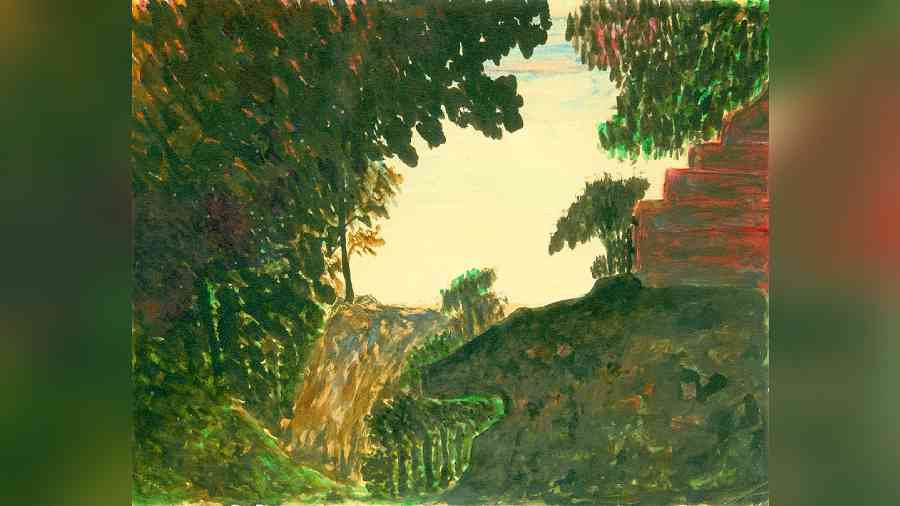It all began with bhnaatphool. More specifically, a photograph of bhnaatphool. @Gramergolpo, a Twitter handle that seeks — hearteningly — to delight its followers with breathtaking images of rural Bengal, had recently posted a photograph of these lovely flowers. The short text accompanying the image stated that the bhnaatphool was a classic, but forgotten, emblem of Bengal’s verdant countryside that once lay sheltered in the dense, emerald shadow of not only large, shady trees but also unheralded bushes, shrubs, vines, creepers and tendrils. The image of these tender white flowers with a tinge of burgundy at the centre brought to mind the September-born Bibhutibhushan Bandyopadhyay, many of whose works carried, in a manner of speaking, to the urbane reader such heady, unknown scents. The poignancy — tragedy — and humanism of Pather Panchali, Aparajito or, say, Aranyak notwithstanding, his novellas and — this point cannot be overstressed — short stories reveal Bibhutibhushan to be one of the finest craftsmen of the minutiae — light and darkness, seasons and skyline, rivers and landscapes — that constitute the iconography of gram Bangla.
Consider some of the following — magical — offerings from this writer. “Makal-Lotar Kahini” follows an enchanted human gaze as it drinks in the beauty of feral vegetation — makal-lota, shaora, bhnaat, bonkochu, sandhyamoni — spawned and nourished by the lazy waters of a quiet river.
Even the inky dusk of the countryside had been touched by Bibhutibhushan’s luminescence. “Mouriphool” remains etched in the mind in this context, with its descriptions of a bamboo forest — bnaashbon — being lit up by the twinkling light of fireflies, even as darkness gathers on the wings of bats that hang upside down from palm trees that surround the taal-pukur.
But when light dawns, it could reveal a shrivelled, skeletal landscape with the brown, parched fields, as if on fire, raising whorls of dust and sand — something that Madhan Shiromani, an old man, glimpsed at as he journeyed during Bengal’s fearsome summer in “Jalshatra”.
Then the earth would cool, with heavy, dark clouds unleashing rain that blurred the swaying trees behind a white, misty spray: Pratul had watched the fury of the monsoon in “Kuwashar Rong.”
This exquisite detailing of the rhythms of nature, the natural world and the wilderness had earned Bibhutibhushan the label of a ‘romantic’, a charge that Jitendranath Chakrabarty swats away in his revealing introduction to the first volume of Bibhutibhushan’s collected short stories. Chakrabarty describes the writer as that rare artist who had fused romanticism and realism in perfect measures. It takes a particularly potent form of myopia to miss the rough edges of realism that shape Bibhutibhushan’s literaryscape. For the unparalleled splendour of nature seldom conceals the eclipsing of life by death. In his works, characters — often women and children — die painful deaths. Umarani, a young woman, perishes, eaten away by loneliness, longing and affliction (“Umarani”); Khenti, that quiet, gentle, greedy adolescent girl is devoured by a cruel marriage and, finally, by disease (“Pnui Macha”); Khoka, a child, dies too, before his young friend, Tuni, can visit him after a fracas (“Thyalagari”). Then there is, of course, the short-lived, luminescent Durga.
In his portrayal of nature’s benevolence and rage — rain, storm, floods, contagions — Bibhutibhushan, albeit unwittingly, provides an important balance between two philosophical traditions. The rationalist school — from Newton to Descartes — Andrea Wulf argues in a compelling essay in The New York Times, had stripped nature of sentience, transforming flora, fauna and, indeed, terra firma into inert, cold entities to be studied objectively. This, around the early-nineteenth century, was challenged by Friedrich Schelling’s naturphilosophie, a philosophical position that sought to set right humanity’s organic relationship with the natural world. Not just Schelling but Goethe, Hegel, Alexander von Humboldt, along with England’s Romantics and, in India, Tagore and Gandhi, among many others, perturbed with rationality’s role in disseminating a mechanical reading of nature, advocated oneness with the wilderness as a means of discovering both the world and the self.
Bibhutibhushan, arguably, introduced a caveat. The world he made us see could be bountiful and beautiful: Aranyak, despite its setting outside Bengal’s lush hinterland, is teeming with absolutely enchanting passages describing the moonlit forests of Lobtulia, Baihar and Azamabad. Yet, Aranyak also reminds us that these forests can be harbingers of death and destruction: Bibhutibhushan’s description of a forest fire appears like a premonitory message for our Anthropocene world that lost an estimated one-third of its tree cover in 2021 to these infernos.
There is thus a case to reappraise Bibhutibhushan, over seven decades after his death, as one of the exponents of the genre that goes today by the name of Ecofiction, which has produced such an astounding body of works examining the diverse aspects of, what Amitav Ghosh has so aptly titled, The Great Derangement.
Did Bibhutibhushan suggest a way out of this madness? An affirmative answer would lead us into the realm of speculation. But none can doubt the magnetic pull of the hinterland and its lushness on Bibhutibhushan’s men and women — banished to Kashi in her old age, Drobomoyi, an old but spirited woman who thinks nothing of questioning the stifling rituals of faith, dreams, quite often, of her village — her home — with its chiaroscuro evenings, thick grove of trees — knathal and dumur — and, of course, Moongli, her cow. She returns, and is reassured to discover that Gopinathpur’s evenings, sweetened by the sharp aroma of ghnetkol and bhnaat rising from the surrounding bushes, have remained unchanged (“Drobomoyir Kashibash”).
In this turbulent — terminal? — age of changing climate, extreme weather events and their attendant losses — ecological and spiritual — could the longing to return — to revive — that was experienced by so many of the characters created by Bibhutibhushan be a form of capital in our battle against climatic Armageddon?
In our absorption with kaashphool in autumnal Bengal, we must not ignore the odour of bhnaatphool.
uddalak.mukherjee@abp.in
Uddalak Mukherjee










